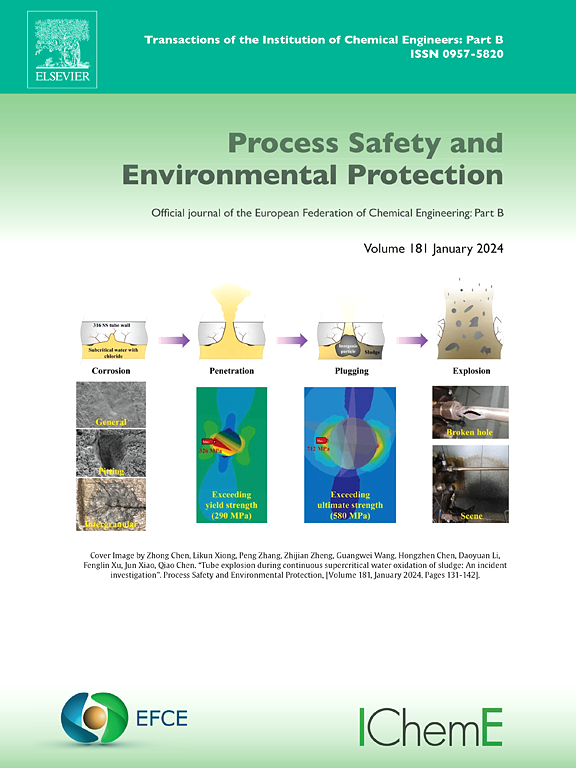利用统计、小波变换和机器学习方法综合分析泄漏对液气多相流的影响
IF 6.9
2区 环境科学与生态学
Q1 ENGINEERING, CHEMICAL
引用次数: 0
摘要
相比于识别较大的泄漏,特别是在多相流条件下,检测小的、细微的、紧密间隔的泄漏更具挑战性。目前的模型无法一致地检测小泄漏或区分多个泄漏和单个泄漏,这突出了对增强检测技术的需求。尽管单次泄漏和多次泄漏的压力响应随时间的变化非常相似,但频率分析、小波分析和人工智能等附加分析可以区分这些情况。本研究对直径为50.8 mm的水平回流系统进行了实验测试,该系统在管道中段设置了3个可控人工泄漏。统计、小波变换(WT)和机器学习(ML)方法应用于记录的时间序列信号(动态压力),用于各种操作条件下的液体和气体表面速度。我们的研究结果表明,这些额外的分析可以有效地区分单泄漏、多泄漏和无泄漏的情况。此外,还讨论了泄漏对管道流态图的影响。揭示的结果可以为过程安全和风险工程提供新的视角,包括泄漏对多相流系统的影响及其识别。本文章由计算机程序翻译,如有差异,请以英文原文为准。
Comprehensive analysis of leak impacts on liquid-gas multiphase flow using statistical, wavelet transform, and machine learning approaches
Detecting small, subtle, and closely spaced leaks is considerably more challenging than identifying larger leaks, particularly under multiphase flow conditions. The inability of current models to consistently detect small leaks or distinguish between multiple leaks and a single leak highlights the need for enhanced detection techniques. Although pressure responses over time for single and multiple leaks are highly similar, additional analyses such as frequency analysis, wavelet analysis, and artificial intelligence can distinguish between these scenarios. In this study, experimental tests were performed on a horizontal flow loop system with a diameter of 50.8 mm equipped with three controlled artificial leaks in the middle section of the pipeline. Statistical, Wavelet Transform (WT), and Machine Learning (ML) approaches were applied to the recorded time-series signals (dynamic pressure) for various operating conditions of liquid and gas superficial velocities. Our findings demonstrate that these additional analyses can effectively distinguish between single-leak, multiple-leak, and no-leak scenarios. Additionally, the impact of leaks on the flow regime map in a pipeline was discussed. The revealed results could offer novel perspectives regarding process safety and risk engineering including the impact of leaks on multiphase flow systems and their identification.
求助全文
通过发布文献求助,成功后即可免费获取论文全文。
去求助
来源期刊

Process Safety and Environmental Protection
环境科学-工程:化工
CiteScore
11.40
自引率
15.40%
发文量
929
审稿时长
8.0 months
期刊介绍:
The Process Safety and Environmental Protection (PSEP) journal is a leading international publication that focuses on the publication of high-quality, original research papers in the field of engineering, specifically those related to the safety of industrial processes and environmental protection. The journal encourages submissions that present new developments in safety and environmental aspects, particularly those that show how research findings can be applied in process engineering design and practice.
PSEP is particularly interested in research that brings fresh perspectives to established engineering principles, identifies unsolved problems, or suggests directions for future research. The journal also values contributions that push the boundaries of traditional engineering and welcomes multidisciplinary papers.
PSEP's articles are abstracted and indexed by a range of databases and services, which helps to ensure that the journal's research is accessible and recognized in the academic and professional communities. These databases include ANTE, Chemical Abstracts, Chemical Hazards in Industry, Current Contents, Elsevier Engineering Information database, Pascal Francis, Web of Science, Scopus, Engineering Information Database EnCompass LIT (Elsevier), and INSPEC. This wide coverage facilitates the dissemination of the journal's content to a global audience interested in process safety and environmental engineering.
 求助内容:
求助内容: 应助结果提醒方式:
应助结果提醒方式:


